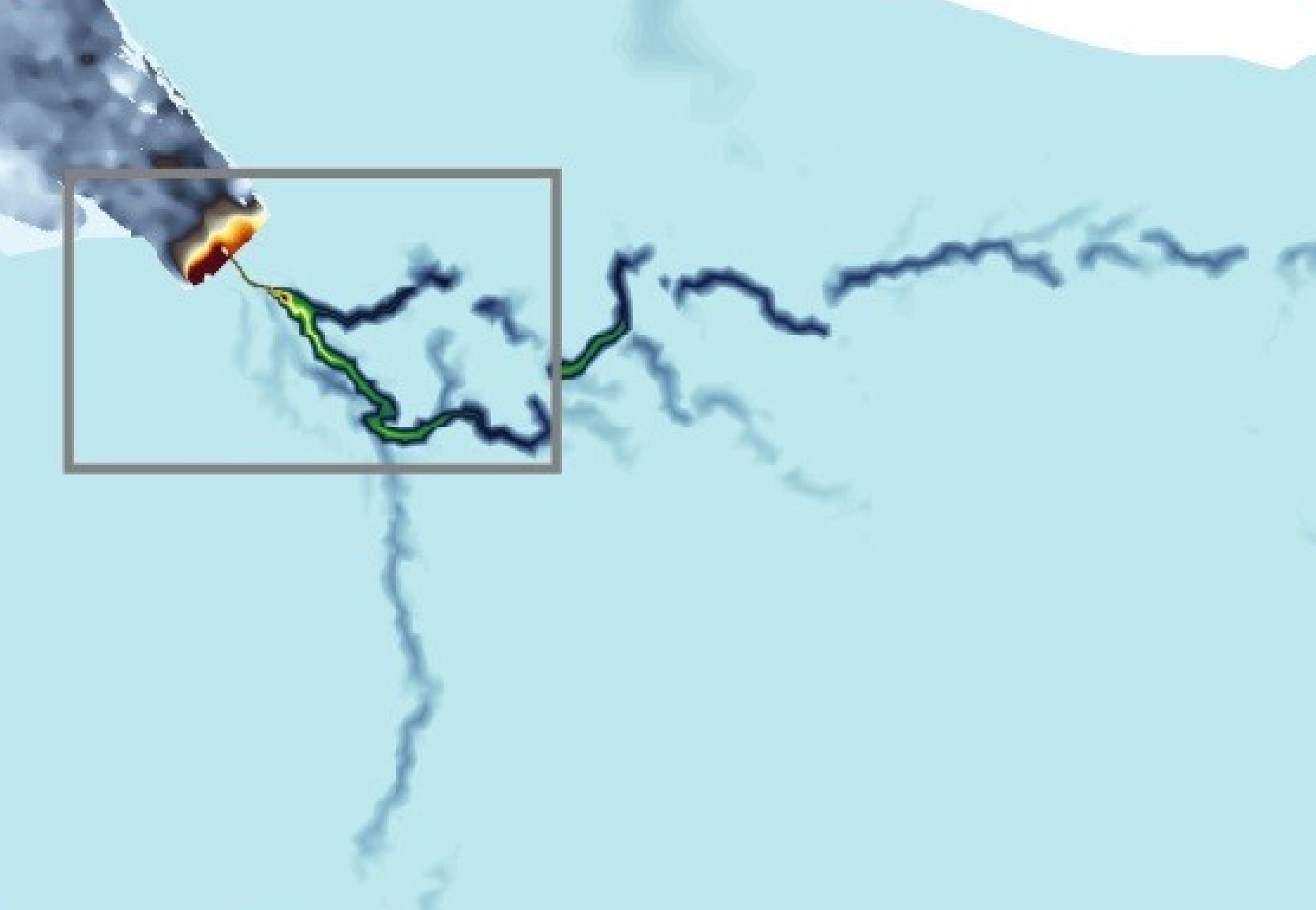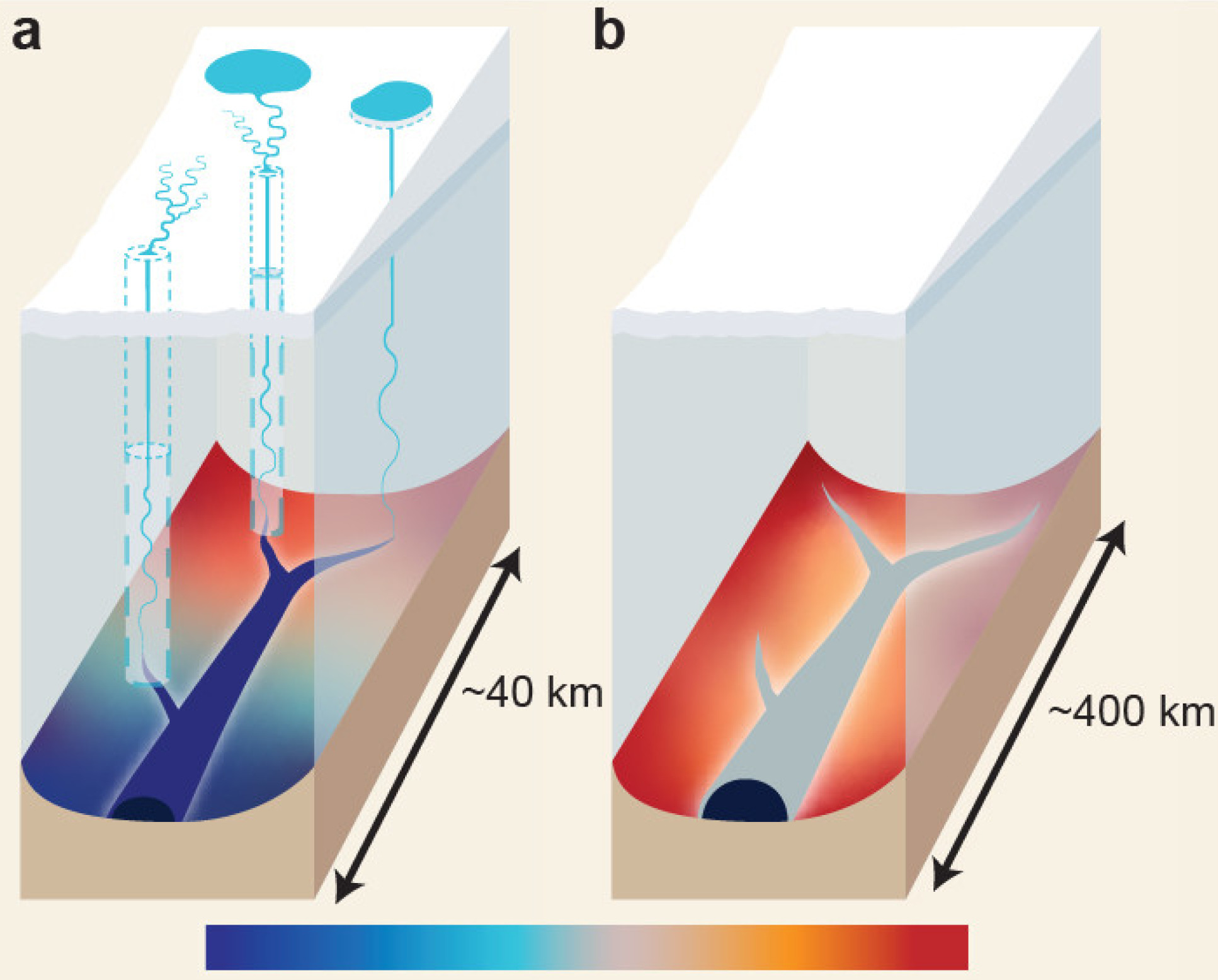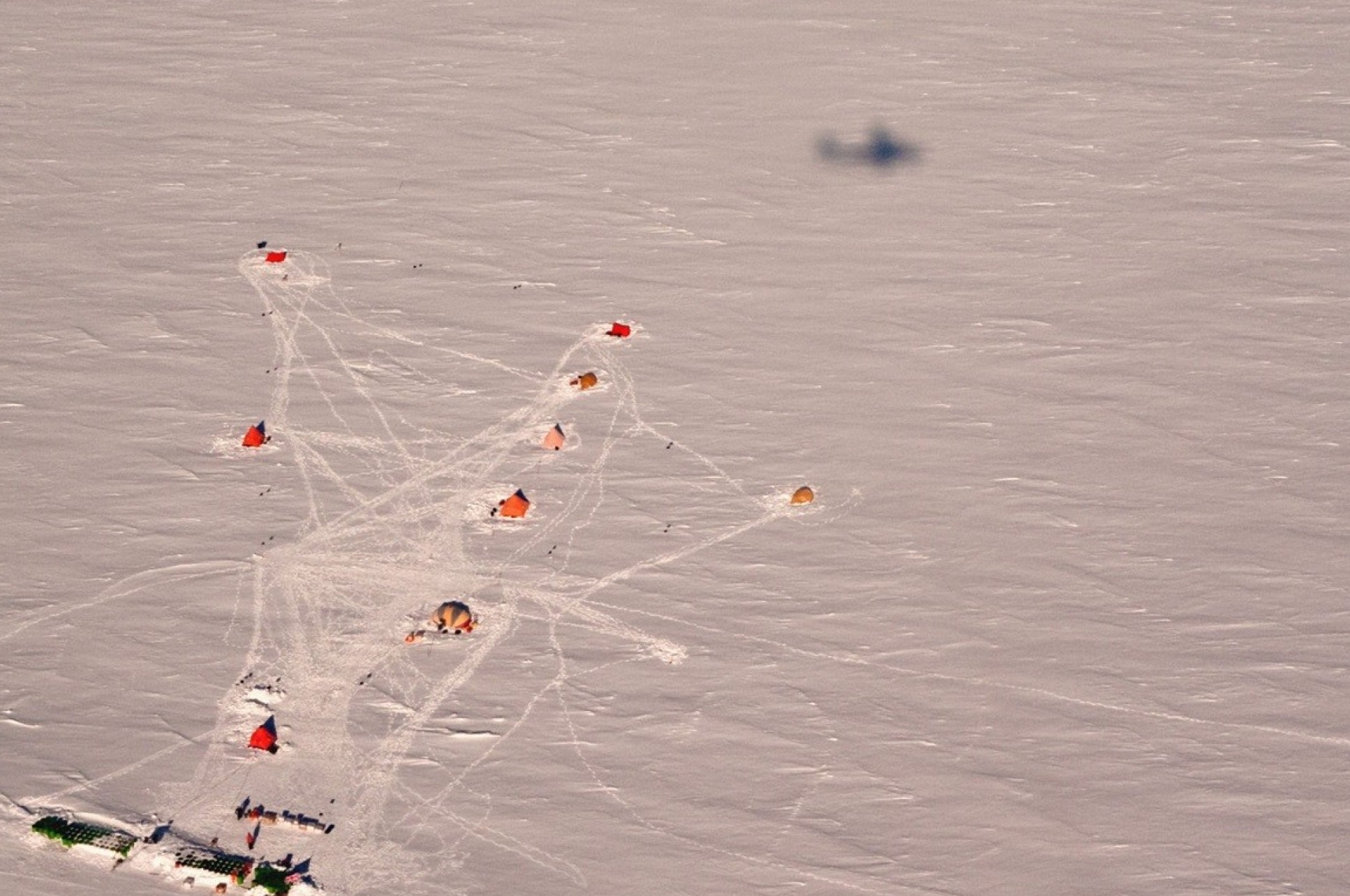From Imperial College London (UK)
10.27.22
Hayley Dunning

An unexpected river under the Antarctic ice sheet affects the flow and melting of ice, potentially accelerating ice loss as the climate warms.
The 460km-long river is revealed in a new study, which details how it collects water at the base of the Antarctic ice sheet from an area the size of Germany and France combined. Its discovery shows the base of the ice sheet has more active water flow than previously thought, which could make it more susceptible to changes in climate.
The discovery was made by researchers at Imperial College London, the University of Waterloo, Canada, Universiti Malaysia Terengganu, and Newcastle University, with the details published today in Nature Geoscience [below].
Co-author Professor Martin Siegert, from the Grantham Institute at Imperial College London, said: “When we first discovered lakes beneath the Antarctic ice a couple of decades ago, we thought they were isolated from each other. Now we are starting to understand there are whole systems down there, interconnected by vast river networks, just as they might be if there weren’t thousands of metres of ice on top of them.
“The region where this study is based holds enough ice to raise the sea level globally by 4.3m. How much of this ice melts, and how quickly, is linked to how slippery the base of the ice is. The newly discovered river system could strongly influence this process.”
Water sources
Water can appear beneath ice sheets in two main ways: from surface meltwater running down through deep crevasses, or by melting at the base, caused by the natural heat of the Earth and friction as the ice moves over land.
However, the ice sheets around the north and south poles have different characteristics. In Greenland, the surface experiences strong melting over the summer months, where immense amounts of water channel down through deep crevasses called “moulins”.

The situations in the Greenland summer (left) and the new system found in Antarctica.
In Antarctica, however, the surface doesn’t melt in sufficient quantities to create “moulins”, as the summers are still too cold. It was thought this meant that there was relatively little water at the base of the Antarctic ice sheets.
The new discovery turns this idea on its head, showing there is sufficient water from basal melt alone to create huge river systems under kilometres-thick ice.
Improving predictions
The discovery was made through a combination of airborne radar surveys that allow researchers to look beneath the ice and modelling of the ice sheet hydrology. The team focused on a largely inaccessible and understudied area that includes ice from both the East and West Antarctic Ice Sheets and reaches the Weddell Sea.

Surveys were carried out using small aircraft. Credit: Dr Neil Ross.
That such a large system could be undiscovered until now is testament to how much we still need to learn about the continent, says lead researcher Dr Christine Dow from the University of Waterloo.
She said: “From satellite measurements we know which regions of Antarctica are losing ice, and how much, but we don’t necessarily know why. This discovery could be a missing link in our models. We could be hugely underestimating how quickly the system will melt by not accounting for the influence of these river systems.
“Only by knowing why ice is being lost can we make models and predictions of how the ice will react in the future under further global heating, and how much this could raise global sea levels.”
For example, the newly discovered river emerges into the sea beneath a floating ice shelf – where a glacier extending out from the land is buoyant enough to begin floating on the ocean water. The freshwater from the river however churns up warmer water towards the bottom of the ice shelf, melting it from below.
Co-author Dr Neil Ross, from the University of Newcastle, said: “Previous studies have looked at the interaction between the edges of ice sheets and ocean water to determine what melting looks like. However, the discovery of a river that reaches hundreds of kilometres inland driving some of these processes shows that we cannot understand the ice melt fully without considering the whole system: ice sheet, ocean, and freshwater.”
A changing Antarctica
The existence of large under-ice rivers also needs to be taken into account when predicting the possible consequences of climate change in the region. For example, if summers warm enough to cause enough surface melt that the water reaches the base of the ice sheet, it could have large effects on the river systems, potentially tipping Antarctica to a Greenland-like state, where ice loss is much faster.
There are also potential feedback loops that would accelerate ice loss. For example, if the ice starts to flow faster as water accumulated at the base, then this will increase friction where the ice runs over dry land, which could increase the amount of basal melting and water produced.
The team are now looking to gather more data about all these mechanisms from surveys to apply their models to other regions and provide a better understanding of how a changing Antarctica could change the planet.
Science paper:
Nature Geoscience
See the full article here.

five-ways-keep-your-child-safe-school-shootings
Please help promote STEM in your local schools.
![]()
Stem Education Coalition
Imperial College London (UK) is a science-based university with an international reputation for excellence in teaching and research. Consistently rated amongst the world’s best universities, Imperial is committed to developing the next generation of researchers, scientists and academics through collaboration across disciplines. Located in the heart of London, Imperial is a multidisciplinary space for education, research, translation and commercialization, harnessing science and innovation to tackle global challenges.
Imperial College London (legally Imperial College of Science, Technology and Medicine) is a public research university in London. Imperial grew out of Prince Albert’s vision of an area for culture, including the Royal Albert Hall; Imperial Institute; numerous museums and the Royal Colleges that would go on to form the college. In 1907, Imperial College was established by Royal Charter, merging the Royal College of Science; Royal School of Mines; and City and Guilds College. In 1988, the Imperial College School of Medicine was formed by combining with St Mary’s Hospital Medical School. In 2004, Queen Elizabeth II opened the Imperial College Business School.
The college focuses exclusively on science; technology; medicine; and business. The college’s main campus is located in South Kensington, and it has an innovation campus in White City; a research field station at Silwood Park; and teaching hospitals throughout London. The college was a member of the University of London(UK) from 1908, becoming independent on its centenary in 2007. Imperial has an international community, with more than 59% of students from outside the UK and 140 countries represented on campus. Student, staff, and researcher affiliations include 14 Nobel laureates; 3 Fields Medalists; 2 Breakthrough Prize winners; 1 Turing Award winner; 74 Fellows of the Royal Society; 87 Fellows of the Royal Academy of Engineering; and 85 Fellows of the Academy of Medical Sciences.
History
19th century
The earliest college that led to the formation of Imperial was the Royal College of Chemistry founded in 1845 with the support of Prince Albert and parliament. This was merged in 1853 into what became known as the Royal School of Mines. The medical school has roots in many different schools across London, the oldest of which being Charing Cross Hospital Medical School which can be traced back to 1823 followed by teaching starting at Westminster Hospital in 1834 and St Mary’s Hospital in 1851.
In 1851 the Great Exhibition was organized as an exhibition of culture and industry by Henry Cole and by Prince Albert- husband of the reigning monarch of the United Kingdom Queen Victoria. An enormously popular and financial success proceeds from the Great Exhibition were designated to develop an area for cultural and scientific advancement in South Kensington. Within the next 6 years the Victoria and Albert Museum and Science Museum had opened joined by new facilities in 1871 for the Royal College of Chemistry and in 1881 for the Royal School of Mines; the opening of the Natural History Museum in 1881; and in 1888 the Imperial Institute.
In 1881 the Normal School of Science was established in South Kensington under the leadership of Thomas Huxley taking over responsibility for the teaching of the natural sciences and agriculture from the Royal School of Mines. The school was renamed the Royal College of Science by royal consent in 1890. The Central Institution of the City and Guilds of London Institute was opened as a technical education school on Exhibition Road by the Prince of Wales in early 1885.
20th century
At the start of the 20th century, there was a concern that Britain was falling behind Germany in scientific and technical education. A departmental committee was set up at the Board of Education in 1904, to look into the future of the Royal College of Science. A report released in 1906 called for the establishment of an institution unifying the Royal College of Science and the Royal School of Mines, as well as – if an agreement could be reached with the City and Guilds of London Institute – their Central Technical College.
On 8 July 1907 King Edward VII granted a Royal Charter establishing the Imperial College of Science and Technology. This incorporated the Royal School of Mines and the Royal College of Science. It also made provisions for the City and Guilds College to join once conditions regarding its governance were met as well as for Imperial to become a college of the University of London. The college joined the University of London on 22 July 1908 with the City and Guilds College joining in 1910. The main campus of Imperial College was constructed beside the buildings of the Imperial Institute- the new building for the Royal College of Science having opened across from it in 1906 and the foundation stone for the Royal School of Mines building being laid by King Edward VII in July 1909.
As students at Imperial had to study separately for London degrees in January 1919 students and alumni voted for a petition to make Imperial a university with its own degree awarding powers independent of the University of London. In response the University of London changed its regulations in 1925 so that the courses taught only at Imperial would be examined by the university enabling students to gain a BSc.
In October 1945 King George VI and Queen Elizabeth visited Imperial to commemorate the centenary of the Royal College of Chemistry which was the oldest of the institutions that united to form Imperial College. “Commemoration Day” named after this visit is held every October as the university’s main graduation ceremony. The college also acquired a biology field station at Silwood Park near Ascot, Berkshire in 1947.
Following the Second World War, there was again concern that Britain was falling behind in science – this time to the United States. The Percy Report of 1945 and Barlow Committee in 1946 called for a “British MIT”-equivalent backed by influential scientists as politicians of the time including Lord Cherwell; Sir Lawrence Bragg; and Sir Edward Appleton. The University Grants Committee strongly opposed however. So, a compromise was reached in 1953 where Imperial would remain within the university but double in size over the next ten years. The expansion led to a number of new buildings being erected. These included the Hill building in 1957 and the Physics building in 1960 and the completion of the East Quadrangle built in four stages between 1959 and 1965. The building work also meant the demolition of the City and Guilds College building in 1962–63 and the Imperial Institute’s building by 1967. Opposition from the Royal Fine Arts Commission and others meant that Queen’s Tower was retained with work carried out between 1966 and 1968 to make it free standing. New laboratories for biochemistry established with the support of a £350,000 grant from the Wolfson Foundation were opened by the Queen in 1965.
In 1988 Imperial merged with St Mary’s Hospital Medical School under the Imperial College Act 1988. Amendments to the royal charter changed the formal name of the institution to The Imperial College of Science Technology and Medicine and made St Mary’s a constituent college. This was followed by mergers with the National Heart and Lung Institute in 1995 and the Charing Cross and Westminster Medical School; Royal Postgraduate Medical School; and the Institute of Obstetrics and Gynecology in 1997 with the Imperial College Act 1997 formally establishing the Imperial College School of Medicine.
21st century
In 2003, Imperial was granted degree-awarding powers in its own right by the Privy Council. In 2004, the Imperial College Business School and a new main entrance on Exhibition Road were opened by Queen Elizabeth II. The UK Energy Research Centre was also established in 2004 and opened its headquarters at Imperial. On 9 December 2005, Imperial announced that it would commence negotiations to secede from the University of London. Imperial became fully independent of the University of London in July 2007.
In April 2011 Imperial and King’s College London joined the UK Centre for Medical Research and Innovation as partners with a commitment of £40 million each to the project. The centre was later renamed the Francis Crick Institute and opened on 9 November 2016. It is the largest single biomedical laboratory in Europe. The college began moving into the new White City campus in 2016 with the launching of the Innovation Hub. This was followed by the opening of the Molecular Sciences Research Hub for the Department of Chemistry officially opened by Mayor of London- Sadiq Khan in 2019. The White City campus also includes another biomedical centre funded by a £40 million donation by alumnus Sir Michael Uren.
Research
Imperial submitted a total of 1,257 staff across 14 units of assessment to the 2014 Research Excellence Framework (REF) assessment. This found that 91% of Imperial’s research is “world-leading” (46% achieved the highest possible 4* score) or “internationally excellent” (44% achieved 3*) giving an overall GPA of 3.36. In rankings produced by Times Higher Education based upon the REF results Imperial was ranked 2nd overall. Imperial is also widely known to have been a critical contributor of the discovery of penicillin; the invention of fiber optics; and the development of holography. The college promotes research commercialization partly through its dedicated technology transfer company- Imperial Innovations- which has given rise to a large number of spin-out companies based on academic research. Imperial College has a long-term partnership with the Massachusetts Institute of Technology that dates back from World War II. The United States is the college’s top collaborating foreign country with more than 15,000 articles co-authored by Imperial and U.S.-based authors over the last 10 years.
In January 2018 the mathematics department of Imperial and the CNRS-The National Center for Scientific Research[Centre national de la recherche scientifique](FR) launched UMI Abraham de Moivre at Imperial- a joint research laboratory of mathematics focused on unsolved problems and bridging British and French scientific communities. The Fields medallists Cédric Villani and Martin Hairer hosted the launch presentation. The CNRS-Imperial partnership started a joint PhD program in mathematics and further expanded in June 2020 to include other departments. In October 2018, Imperial College launched the Imperial Cancer Research UK Center- a research collaboration that aims to find innovative ways to improve the precision of cancer treatments inaugurated by former Vice President of the United States Joe Biden as part of his Biden Cancer Initiative.
Imperial was one of the ten leading contributors to the National Aeronautics and Space Administration InSight Mars lander which landed on planet Mars in November 2018, with the college logo appearing on the craft. InSight’s Seismic Experiment for Interior Structure, developed at Imperial, measured the first likely marsquake reading in April 2019. In 2019 it was revealed that the Blackett Laboratory would be constructing an instrument for the European Space (EU) Solar Orbiter in a mission to study the Sun, which launched in February 2020. The laboratory is also designing part of the DUNE/LBNF Deep Underground Neutrino Experiment.
In early 2020 immunology research at the Faculty of Medicine focused on SARS-CoV-2 under the leadership of Professor Robin Shattock as part of the college’s COVID-19 Response Team including the search of a cheap vaccine which started human trials on 15 June 2020. Professor Neil Ferguson’s 16 March report entitled Impact of non-pharmaceutical interventions (NPIs) to reduce COVID- 19 mortality and healthcare demand was described in a 17 March The New York Times article as the coronavirus “report that jarred the U.S. and the U.K. to action”. Since 18 May 2020 Imperial College’s Dr. Samir Bhatt has been advising the state of New York for its reopening plan. Governor of New York Andrew Cuomo said that “the Imperial College model- as we’ve been following this for weeks- was the best most accurate model.” The hospitals from the Imperial College Healthcare NHS Trust which have been caring for COVID-19 infected patients partnered with Microsoft to use their HoloLens when treating those patients reducing the amount of time spent by staff in high-risk areas by up to 83% as well as saving up to 700 items of PPE per ward, per week.

